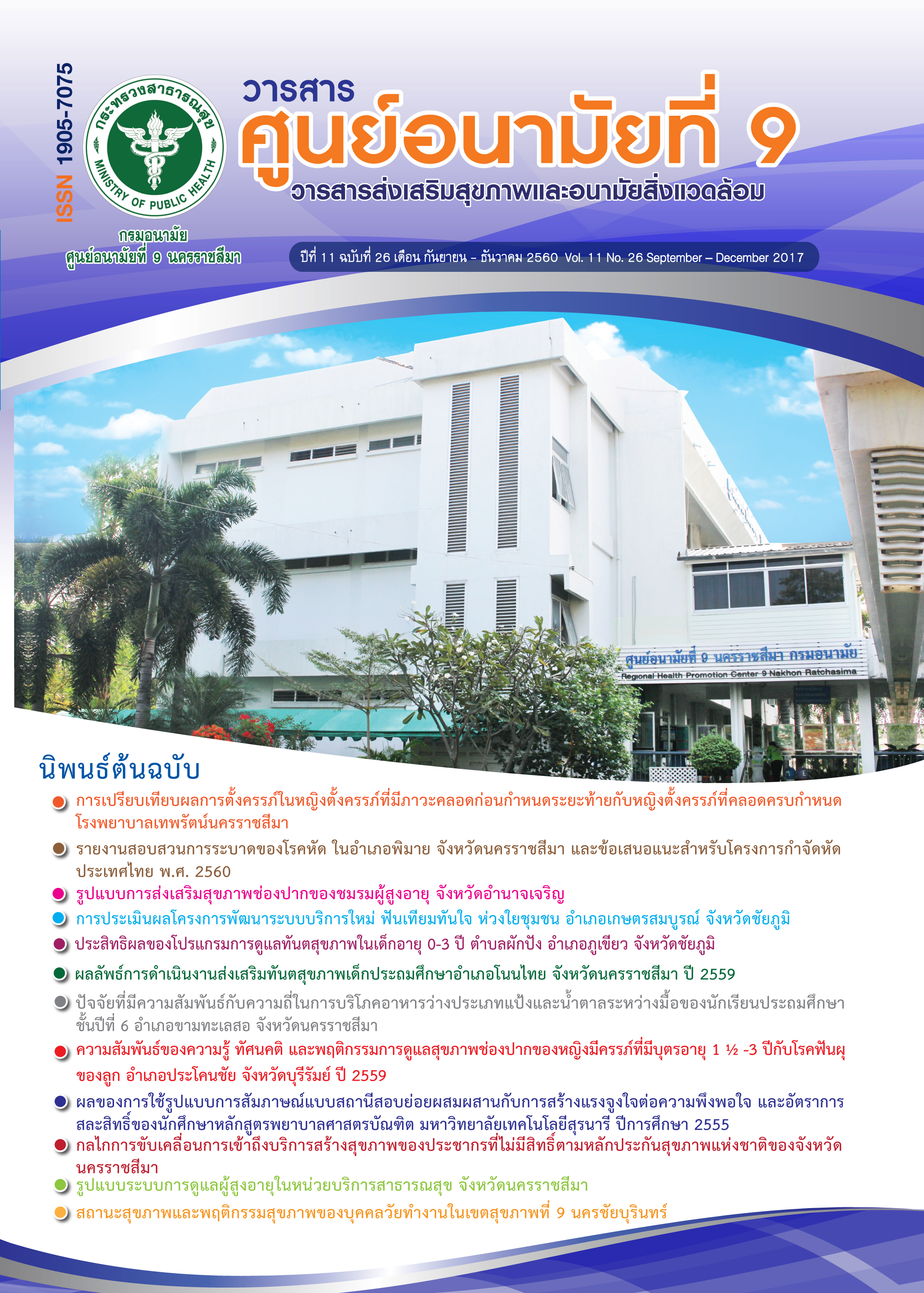Factors Related to Starch and Sugar Consumption between Meals among Elementary School Children Grade 6 from Khamthaleso District, Nakhon Ratchasima Province
Keywords:
Snacks consumption, Dental caries, Diet diaries, Oral Health Promotion SchoolAbstract
This cross-sectional analytic study aimed to assess starch and sugar consumptionbetween meals and to evaluate factors that relate to starch and sugar consumptionbetween meals among elementary school children grade 6 in Khamthaleso district, Nakhon Ratchasima province. The samples were 148 persons. A 24 hours dietary record was collected for 7 days including 5 weekdays and 2 days on weekends. Personal factors, family factors, social and environmental factors were collected by personal information- questionnaires and school questionnaires. The factors were oral health network, sex, stay with parent, occupation of parent, number of children in family, pocket money allowance, experience of oral problem, perception of oral health importance and food control policy. Data were analyzed with descriptive statistics and multiple logistic regression analysis. The results showed mean of frequency of starch and sugar consumption between meals was 1.93 times/day (SD = 1.04). the factors that significantly related to frequency of starch and sugar consumption between meals >2times/day (p-value= 0.05) were experience of oral problem(ORadj = 2.71, 95% CI = 1.27-5.78) and without snack in school policy (ORadj = 5.93, 95% CI = 1.91-18.37). Oral health promotion schools should be creating food control policy. And promote education on the impact of food consumption to oral health.
References
2. Carounanidy U, and Sathyanarayanan R. Dental caries - A complete changeover (Part I).
J Conserv Dent. 2009; 12:2. doi:10.4103/0972-0707.55617.
3. Chanbang P, Prasertsom P, Loungvara P. Participatory Action Research (PAR) : Network Strengthening for pluralistic Partnership In Sweet enough Eating Behavior among Thai Children. Thailand Journal of Dental Public Health 2015; 20(3):31-44. (in Thai).
4. Lingstrom P, Van Houte J, Kashket S. Food starches and dental caries. SAGE Journal 2000; 11(3):366-380.
5. Tharaphiwattananon T, Triratworakul C. Diet Nutrition and Oral health. In Triratworakul C, (eds). Dental prevention in children and adolescents. 4th ed. Bangkok: Best Book Online; 2011. p.314-359. (in Thai)
6. Gupta P, Gup N, Prakash AP, Birajdar SS, Natt AS, Preet Singh H. Role of sugar and sugar substitutes in dental caries: A review. ISRN Dent. 2013;2013:519421.
Doi:10.1155/2013/519421.
7. Koopatishart W. Dental health status and factors associated with dental health status among lowland and hilltribe children in Samoeng district , Chiangmai province. Lanna Plublic Health Journal 2013;9(2):137-150. (in Thai)
8. Oogarah‐Pratap B, Heerah‐Booluck B.J., Children’s consumption of snacks at school in Mauritius. Nutrition & Food Science,2005; 35:1, doi.org/10.1108/00346650510579117.
9. Rashidian A, Feyzabadi VY, Mohammadi NK, Oidvar N, Karimi-Shahanjarini, NS. Factors associated with unhealthy snacks consumption among adolescents in Iran’s school. IJHPM 2017; 6:9. doi:10.15171/ijhpm.2017.09.
10. Keawsawat D. Criteria of oral health promotion school. In Prasertsom P,Rattanarangsima K, (eds). Manual assessment of Oral health promotion school Bangkok: N-mo plus; 2015. P.45-64. (in Thai)
11. Dental Health Bureau. Report of snacks and drinks consumption, Oral Health Care and oral health status of young people in secondary schools. [on line]2013 [cited 2013];Available from: URL:http://dental2.anamai.moph.go.th/ewtadmin/ewt/dental/ewt_dl_link.php?nid=985
12. Thamronglaohapan D. Concept theory of oral health network development. In Prasertsom P,Rattanarangsima K, (eds). Manual assessment of Oral health promotion school Bangkok: N-mo plus; 2015. P.5-10. (in Thai).
13. Prasertsom P, Rityu A, Janbang P. Sugar in snack and beverage. In Prasertsom P, (eds). Sugar sweeteners in desserts, drinks, milk and powdered milk for children. Bangkok: Namo printing and publishing; 2007. P.24.(in Thai).
14. Sardesai V. Nutrition assessment. In Introduction to clinical nutrition. 3rd ed. Boca Raton,FL: CRC Press; 2012. p.350.
15. Borzekowski DL, Robinson TN. The 30-second effect: an experiment revealing the impact of television commercials on food preferences of preschools. J Am Diet Assoc 2001; 101:1. Doi:10.1016/S0002-8223(01)00012-8.
16. Dental Health Bureau. School development model, food and drinks management for students in elementary schools (Phase 1). [online]January 2012 [cited 2012 January]; Available from: URL:http//http://dental2.anamai.moph.go.th/ewtadmin/ewt/dental/ewt_dl_link.php?nid=987&filename=learnage.
17. Stokes E, Pine CM, Harris RV, The promotion of oral health within the Healthy School context in England: a qualitative research study. BMC Oral Health 2009, 9:3 doi:10.1186/1472-6831-9-3.
Downloads
Published
How to Cite
Issue
Section
License
บทความหรือข้อคิดเห็นใด ๆ ที่ประกฎในวารสารศูนย์อนามัยที่ 9 เป็นความคิดเห็นของผู้เขียน บรรณาธิการ คณะผู้จัดทำ และศูนย์อนามัยที่ 9 นครราชสีมา (เจ้าของ) ไม่จำเป็นต้องเห็นด้วย ผู้เขียนต้องรับผิดชอบต่อบทความของตนเอง
ผลการพิจารณาของกองบรรณาธิการและผู้ทรงคุณวุฒิถือเป็นที่สิ้นสุด คณะบรรณาธิการวารสารฯ ขอสงวนสิทธิ์ในการตรวจแก้ไขข้อความให้ถูกต้องตามหลักภาษาและมีความเหมาะสม
กองบรรณาธิการวารสารฯ ขอสงวนสิทธิ์มิให้นำเนื้อหาใด ๆ ของบทความ หรือข้อคิดเห็นใด ๆ ของผลการประเมินบทความในวารสารฯ ไปเผยแพร่ก่อนได้รับอนุญาตจากกองบรรณาธิการ อย่างเป็นลายลักษณ์อักษร และผลงานที่ได้รับการตีพิมพ์ถือเป็นลิขสิทธิ์ของวารสารศูนย์อนามัยที่ 9


